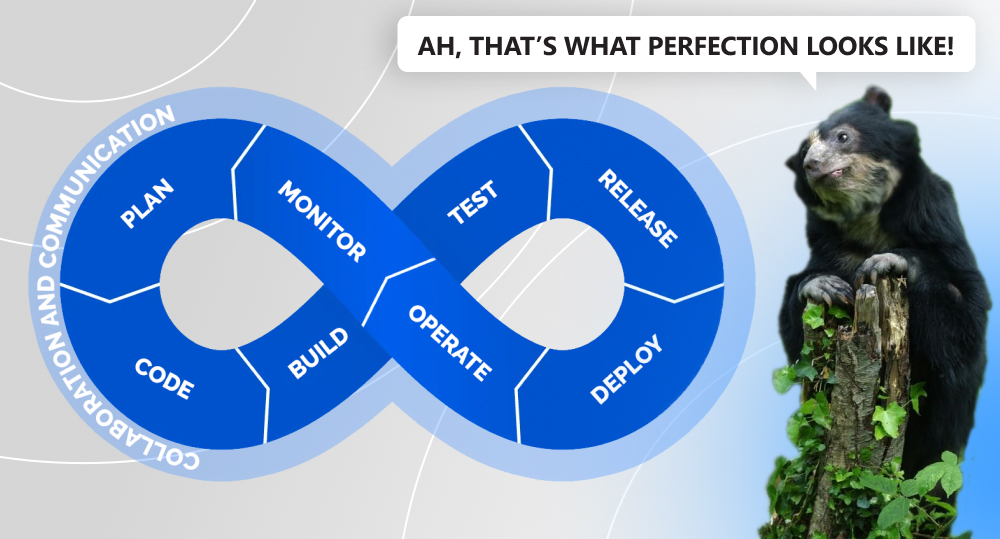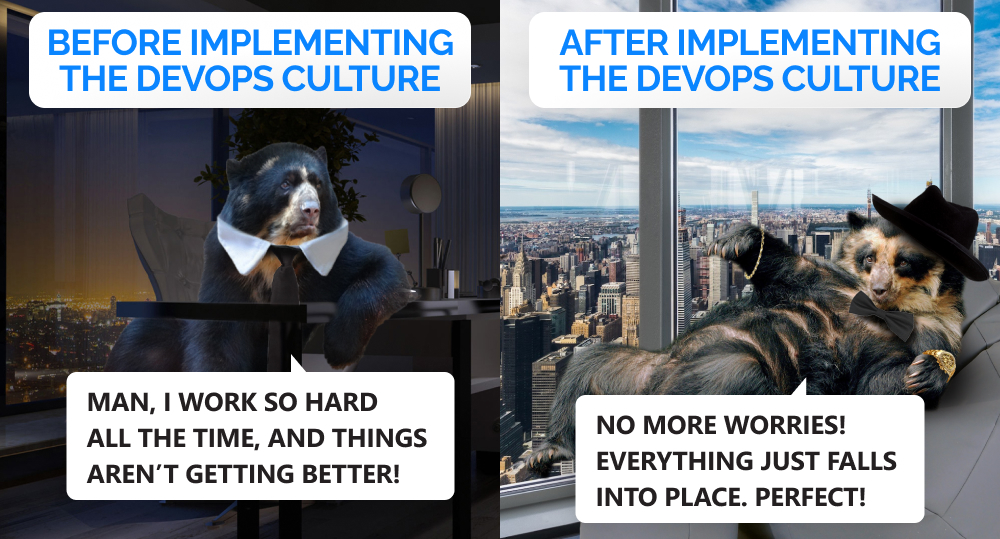If you're here, then you are familiar with the term “DevOps transformation journey”. We bet it has your fullest attention — and for a good reason. As Markets and Markets reports, the global DevOps market size is projected to grow at a CAGR of 19.7% to reach USD 25.5 billion by 2028 from an estimated USD 10.4 billion in 2023. It is no wonder that companies all around the globe want to catch up with the wind of opportunity and rush towards DevOps adoption: as the Atlassian research suggests, 99% of respondents say that DevOps has had a positive impact on their organization.
Let's explore what a DevOps transformation roadmap looks like.
written by:
Alexey Krutikov
Senior Project Manager
Contents
Tradition, DevOps, and Digital Transformation: How Is Everything Connected?
According to Atlassian, the DevOps movement started as the response to the concerns about the traditional software development model, “where developers who wrote code worked apart from operations who deployed and supported the code.” I.e., in that model, a software development life cycle is a linear process with a strict hierarchy and siloed development teams and operations teams. This approach is likely to lead to the following issues:
- A development team and an operations team have conflicting missions: the quality assurance stage begins only after the developers are done with the code and have moved on to a different project, which slows down the process right from the start;
- Information security and readiness for deployment in production environment are checked last before roll-out, which means these teams work on a tight timeframe;
- Lack of communication between the teams leads to non-transparency of the process, misunderstandings, and setbacks that cost companies both time and money. It also makes project documentation chaotic and complex, and stuff needs to waste a lot of time to retrieve necessary information;
- Consequently, deployment turns out to be a high-risk and complex event that might cause significant downtime and functionality issues in a product;
- Unclear common goals and communication issues mean that business objectives are hard to achieve. Because of that, you acquire technical and financial debt after the release, get reduced productivity and low customer satisfaction rates.
As you can see, the step-by-step method doesn't work well in the software development field these days because the industry requires companies to be lightning-bolt fast to adjust to emerging market trends and demands accordingly. Nevertheless, the market mostly consists of large corporations, with legacy systems and bureaucracy, that struggle to transform since they're very used to operating in the traditional way.
The solution to this problem resides in digital transformation. That is a process of using technology to create or modify business processes to meet new market demands. Research and Markets say that, “the global digital transformation market is expected to grow from USD 469.8 billion in 2020 to USD 1,009.8 billion by 2025, at a CAGR of 16.5% during the forecast period.” However, not all that glitters is the smooth sand of the innovation land. Deloitte writes, “70% of transformation efforts fail, and it takes around three years for organizations to even begin competing in the digital market, even when they get it right. At the heart of most failures is not the technology, it’s the people. The most prevailing reasons for failure? ‘Management behavior not supporting change’ and ‘employee resistance to change’.”
This statement leads us to a simple conclusion: even though digital transformation can supply a company with great tech to increase its agility and responsiveness to customer demands, your first step is to adopt a new culture that would create space for innovation.
And this is where the DevOps digital transformation steps forward.
What Does DevOps Mean? DevOps Practices and Mission
DevOps appeared from the merge of the words ‘development’ and ‘operations’ signifying the integration of these two processes into one but continuous. As per AWS, “DevOps is a combination of cultural philosophies, practices, and tools that increases an organization’s ability to deliver applications and services at high velocity.”
Unlike the traditional model, DevOps doesn't focus on big, high-risk releases, late quality assurance tests, and deadlines that have stakeholders breathing down the necks of the dev and operations teams. Instead, the DevOps methodology aims at improving the workflow throughout the whole software development lifecycle and shortening it. It's all about the cultural shift with teamwork at its core, where companies quickly implement new ideas instead of burying them under six feet of formalities.
Below, you can see the infinite loop that represents the stages of the concept: plan, code, build, test, release, deploy, operate, monitor, and plan again with the help of feedback, which ultimately makes the loop start again. As TechTarget writes, “Ideally, DevOps means that an IT team writes software that perfectly meets user requirements, deploys without any wasted time, and runs optimally on the first try.”
Let's take a look at the best DevOps practices that help the DevOps implementation go smoothly:
Collaboration and communication
In the DevOps culture, different teams work towards the same goals and bear the responsibility for the entire product lifecycle together. To foster transparency and dialogue, companies arrange awareness programs, team buildings, and make online communication via chats and video more common.
Wide application of DevOps automation tools and technologies
For a successful DevOps transformation process, it is crucial to automate:
- CI/CD pipelines to shorten time to market;
- log management and monitoring to evaluate how application and infrastructure performance impact the end user experience and quickly resolve arising issues;
- application deployment to speed up software delivery from testing environments to production;
- running automated testing scenarios to efficiently detect errors and avoid setbacks.
Continuous feedback mechanism
DevOps mindset, DevOps principles, and DevOps journey are all customer-centric. To deliver software that would meet user expectations, you need to gather proper feedback. Since stakeholders (QAs, developers, operations, product owners, etc.) start working together, the feedback collection and response process become more accurate and efficient.
Containerization
Containerization allows placing an application’s code with all the files, libraries, and the environment into an isolated unit called “container”. Developers can deploy and run apps on any operating system and device without rewriting code. This DevOps practice results in increased portability, agility, and fault tolerance, since one container doesn’t affect the performance of others.
Serverless computing
Infrastructure tasks are routine, time-consuming, but necessary. In traditional development, it's the team that takes care of them. With DevOps in the picture, it's best to let your stuff focus on building and deploying apps and delegate infrastructure maintenance to serverless providers, like AWS Lambda, Azure Functions, Google Cloud Functions, and more.
DevOps performance monitoring
One of the main DevOps goals is to deliver products to market faster. It is vital to measure DevOps performance. Continuous monitoring of deployment time, failure rate, and mean time to repair estimate the overall DevOps performance, track trends, and help address existing issues.
Microservices
The microservice architecture makes it possible to build a product as a set of small services, where each of them runs independently through APIs and serves a certain business purpose. This DevOps practice allows you to perform spot changes and create stable, scalable, and technologically advanced applications.
DevOps in Digital Transformation: Benefits
Through utilization of automation tools and technology adoption, DevOps provides space for dynamic changes, makes products more testable and flexible. This leads companies to the following benefits:
- Improved workflow and increased productivity*;
- Better communication between the teams;
- High deployment frequency and quick adaptation to new market demands;
- Improved product quality;
- Faster time-to-market and cost-efficiency;
- Lower failure and risk rates.
*According to the report by Deloitte, 61% of respondents say that the DevOps methodology allowed them to produce higher quality deliverables; 49% say they see a faster time-to-market; 49% state that DevOps experts helped improve their deployment frequency.
DevOps Transformation Roadmap: 6 Essential Steps
For the successful implementation of the DevOps best practices, you need a proper DevOps transformation strategy. A roadmap of this shift may consist of the following steps:
Step 1. Planning and Preparation
Your first step is to create a strategy and a clear DevOps transformation plan. The desire to preserve a competitive edge in the market shouldn't be the only driver behind the transformation. Move forward with your unique business goals and objectives in mind.
Also, before going for the big shift, make sure to perform an infrastructure audit. It will highlight your requirements, help you identify bottlenecks, estimate performance, and see if there is room for DevOps in general. Next, define your team structure and scope, give out roles and responsibilities, and appoint a DevOps team as well as other tech experts. Lastly, verify that your software development pipeline works as expected with automated CI/CD.
Step 2. Team
Speaking of the team — before diving into the DevOps transformation process, check if your team has a good understanding of DevOps tools. Since one of the main ideas of DevOps transformation is continuous improvement, make sure your employees are motivated to learn new skills. Amongst quality and popular DevOps tools there are Docker, Chef, Jenkins, Juju, Splunk, and many more others.
In addition, you can build a DevOps Center of Excellence within your company. As TechTarget writes, at the core of this framework lies “a cross-functional team that provides leadership, best practices, and research to support automation efforts across the organization.” These specialists can show the value of DevOps transformation to the wider company.
*If you’re looking to hire DevOps engineers, check out our blog to learn how.
Step 3. Tools, Automation, and QA Alignment
The market is filled with DevOps tools that simplify development, test, and deployment processes. The means you choose to implement DevOps transformation in your organization have to comply with your unique business objectives and be compatible with your IT infrastructure.
Then, it's time to proceed with test automation and QA coordination. As for the former, before automating any test, see how many iterations it will require and decide if this step is worth the time and energy. As for the latter, hire a QA coordinator who will ensure that the organization's QA processes and standards are met. This will also help ensure that the development team and the QA work well together to spot errors beforehand and fix them prior to the next release.
Step 4. Workflow Management
Here, your goal is to establish the DevOps culture in the organization: raise awareness about the collaboration, empower teams, and conduct regular check-ins to streamline communication. Also, decide how you're going to set, track, and update KPIs in your DevOps teams continuously, since without such data, DevOps transformation can never happen. You can track many DevOps metrics, e.g., deployment frequency (DF), time, and failure rates, mean time to recovery (MTTR), change volume, change failure rate (CFR), lead time for changes (LT), and others. DF, MTTR, CFR, and LT make up the DORA metrics which are the key performance indicators of DevOps teams.
Step 5. Pilot Programs
At this stage of your DevOps journey, you need to test the work you've done so far, and pilot testing is your best shot. It is something end-users perform prior to production deployment of the full DevOps transformation process. Customers do continuous and regular testing to find bugs and report them back to the dev team instantly. While running pilot programs, be aware of the key metrics we've mentioned above and your main goals.
Step 6. Implementation of the DevOps Process
If you're pleased with how your transformation progresses and the metrics tell you the entire organization is ready for it, then your last step is to fully go for it. However, if you have doubts, then you can sign up for a cloud & DevOps continuous transformation course or reach out to a tech or implementation partner. After all, DevOps adoption requires in-depth knowledge of the subject, the right tools that are in sync with the latest tech stack, and highly experienced people on board. It's okay to partner up with a tech company* to avoid bottlenecks and obtain new skills.
*If you are in need of a technical partner, we will be happy to give you a hand. Visit our website to view the DevOps services we provide.
FAQ
#1. What is DevOps transformation?
That is a transformation of work culture in a company to make both the team and the workflow more agile.
#2. Is DevOps a digital technology?
DevOps is a methodology rather than a technology, but it is part of digital transformation.
#3. What is the goal of DevOps transformation?
Its goal is to increase productivity and speed up time-to-market through workflow automation and continuous improvement.
#4. What is the role of DevOps in digital transformation?
Digital transformation and DevOps are closely connected. Digital transformation aims at helping businesses meet customer demands more efficiently, and DevOps actively participates in the process by breaching the gap between development and operations teams and speeding up the workflow.
#5. How do I start DevOps transformation?
Align your business objectives, communicate with the team, and introduce new practices that would serve your unique needs.
#6. How to lead DevOps transformation?
Changes should start from the top, so to lead the transformation, you have to acquire new skills and be open to dialogue with your team. Gently establish a new workflow, keep an eye on KPIs, and get a very good understanding of your business goals.
#7. What is the roadmap of DevOps?
In the example we offer above, the DevOps transformation steps include planning and preparation, assembling a team, working with tools, automation, and QA alignment, arranging workflow management, running pilot programs, and implementing DevOps.
DevOps Transformation without Hesitation
DevOps transformation is not easy. It requires a lot of resources, with people being at its core. However, if you explore all the weaknesses of your company well enough to turn them into strengths and set your goals right, the outcome will pleasantly surprise you. And if you need help with this journey, you can always find support.
Speaking of support — if you want to have a consultation or to start the transformation right away, contact us! We will implement DevOps practices into your company so seamlessly, as they’ve always been there.

Contacts
Feel free to get in touch with us! Use this contact form for an ASAP response.
Call us at +44 151 528 8015
E-mail us at request@qulix.com









